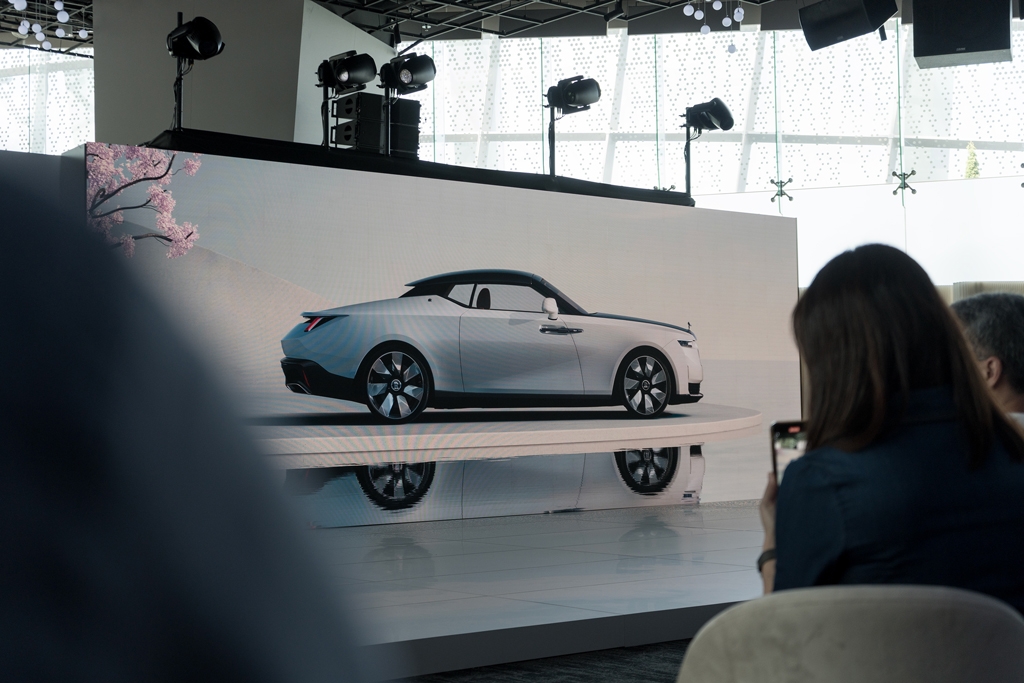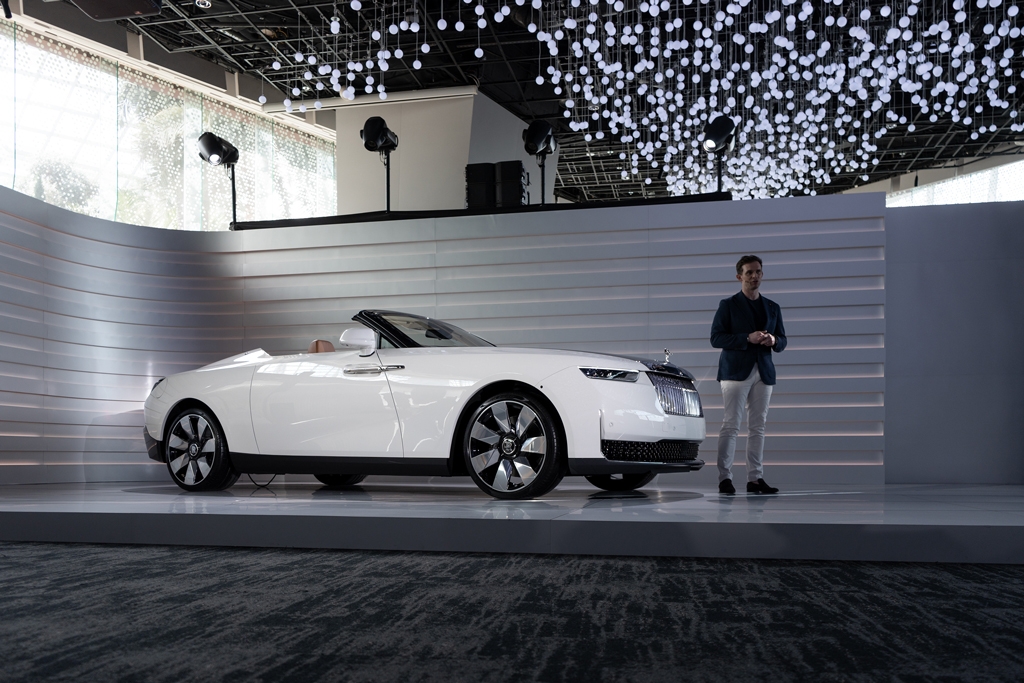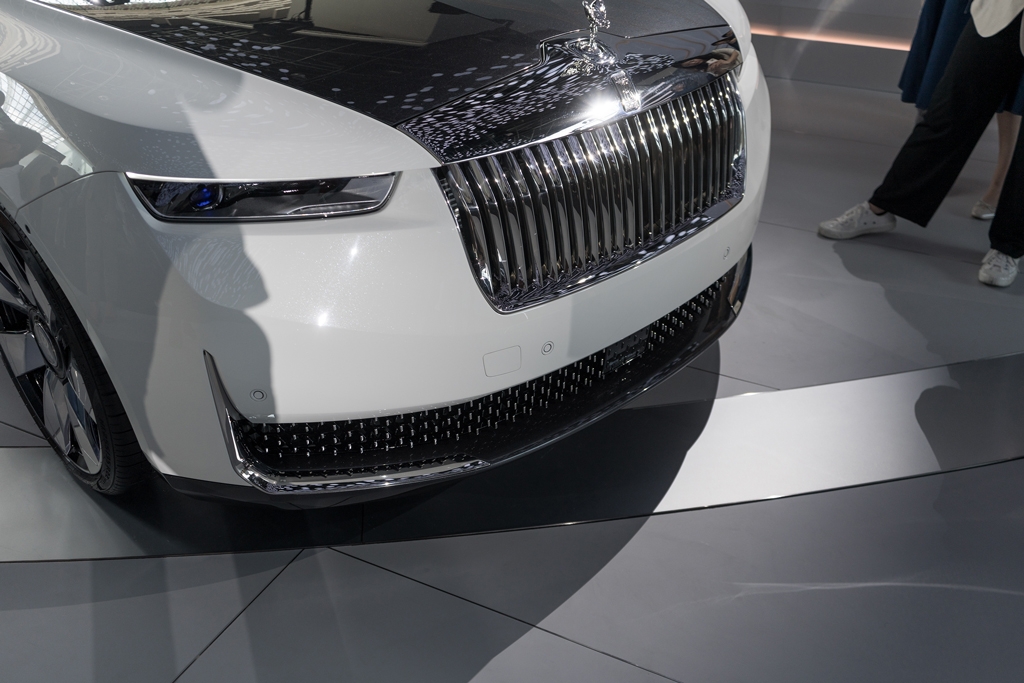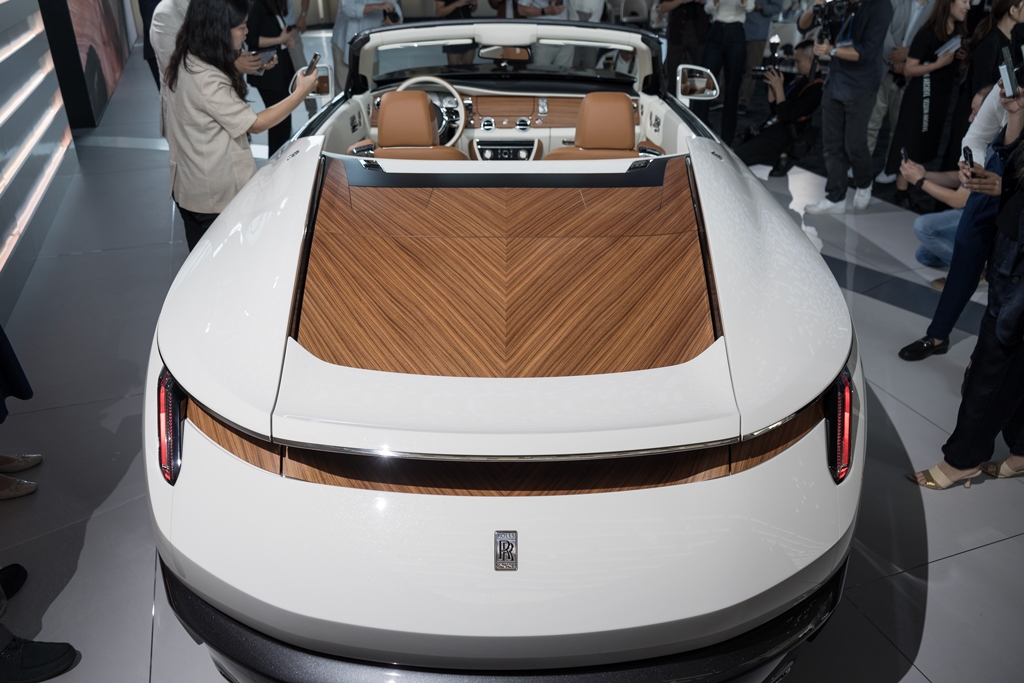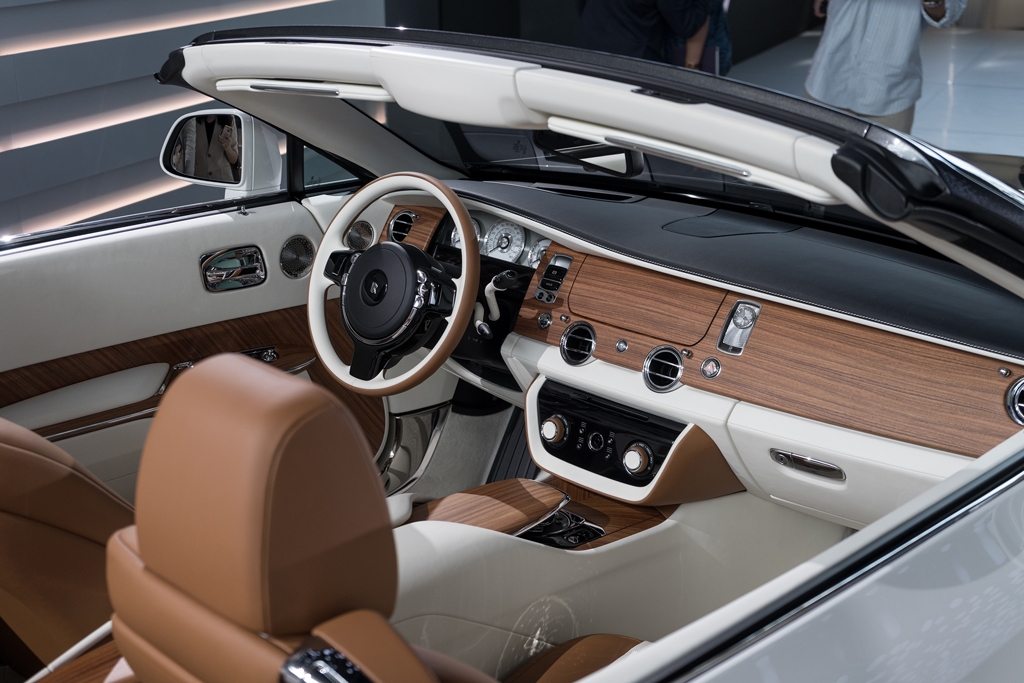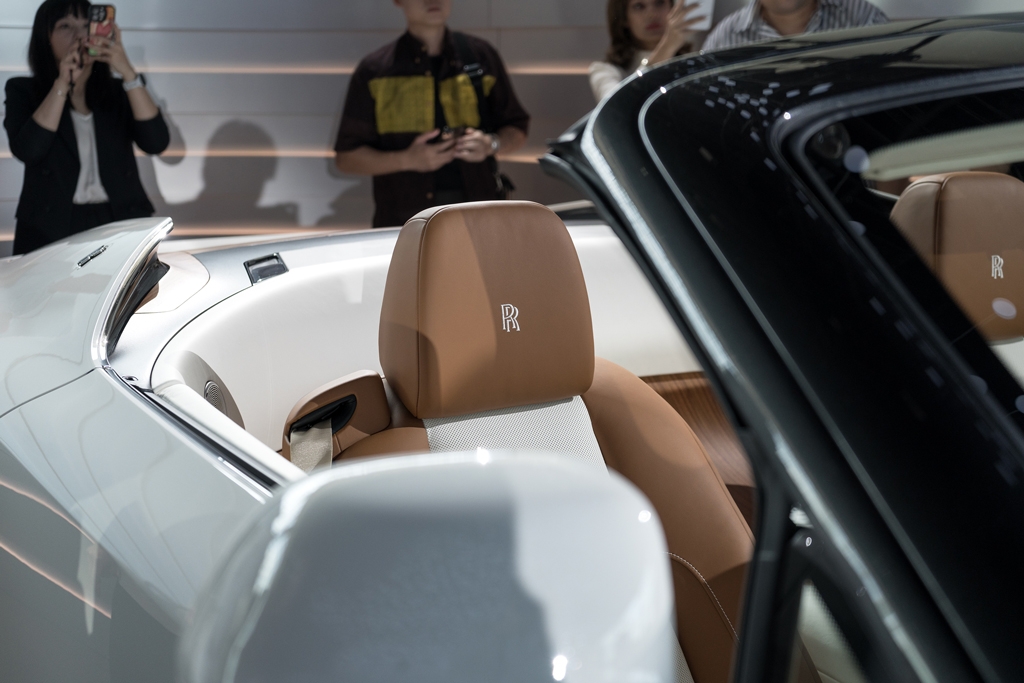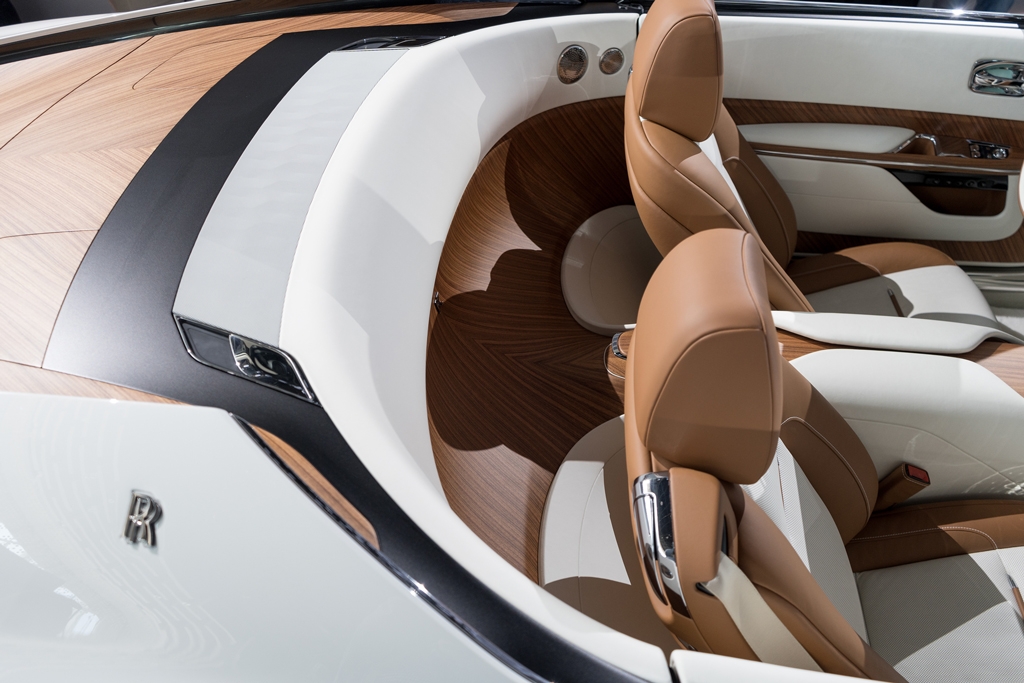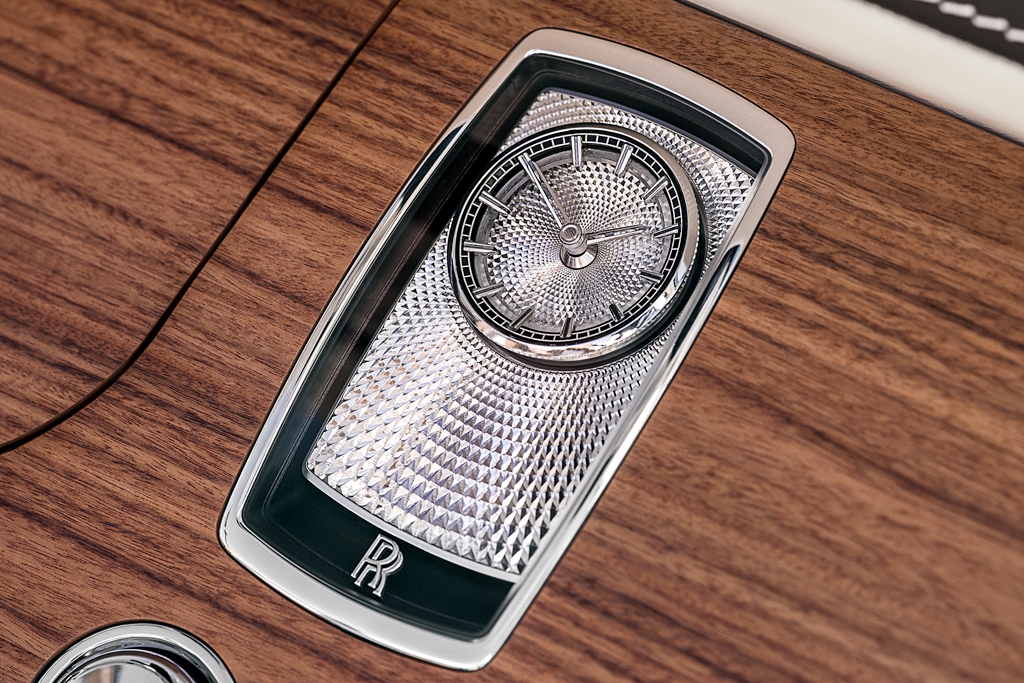Rolls-Royce Arcadia Droptail unveiled in Singapore
01 Mar 2024|8,231 views
Rolls-Royce Motor Cars has taken the covers off the Arcadia Droptail at an exclusive event that took place at Flower Field Hall, located within the Flower Dome at Gardens By the Bay. The marque claims it is the first time that a coachbuilt Rolls-Royce has been presented in Asia.
The Arcadia Droptail is the third of four variants in the carmaker's Droptail series of coachbuilt models. The first variant to debut was the La Rose Noire Droptail, which is inspired by the Black Baccara Rose. It was followed by the Amethyst Droptail, which takes inspiration from the birthstone of the client's son.
The 'Arcadia' name, on the other hand, is derived from Arcadia, a place depicted in Greek mythology as 'Heaven on Earth'. The roadster was envisioned by its owner as a "serene place characterised by reduction, material depth and tactility that would serve as a refuge from the complexities of their business life".
The Arcadia Droptail's unique design sees the 'RR' logo relocated from the fender to aft of the window, while the turn signal indicators are integrated with the door handles
Bringing the client's vision to life
A coachbuilt Rolls-Royce is supposedly the ultimate expression of its owner's identity and passions. In designing the Arcadia Droptail, Coachbuild designers studied the design, sculpture and architecture from the client's favourite regions around the world.
These included the British 'Biomimetic' architecture, along with modernist tropical sky gardens found in Singapore, Indonesia and Vietnam. The owner is said to have insisted that the car should be "absolutely faithful to the earliest hand-drawn sketch they were first presented with in 2019".
Despite being a roadster, the Droptail's nautical influence remains clear, thanks to the 'sail cowls' that resemble the jib on a yacht. Rising behind the rear-hinged doors and curving inwards, their purpose is to also draw attention the car's occupants.
The paintwork's purpose is to define a 'timeless white'. It looks plain from afar, but as one approaches, the sparkle within the finish becomes obvious. This comes about due to the aluminium and glass particles infused in the paint.
In contrast to the other Droptail models of the series, the carbon fibre used in the Arcadia's lower section is painted in Bespoke silver, instead of being exposed. Complementing this are the mirror-polished 22-inch alloy wheels, and the front grille that features kinked vanes.
Santos Straight Grain is also used to trim the cabin, while these Bespoke white and tan hues are exclusively reserved for use by the Droptail's owner
On-board refinements
The Arcadia Droptail's interior, too, reflects its owner's personal aesthetic, which Rolls-Royce says is also found in the client's residences and business spaces worldwide.
The wood used to trim the cabin is Santos Straight Grain, chosen for both its texture, 'visual intrigue' and interlocking grain pattern. The properties of the wood itself presented a challenge for the woodworkers, for it can easily crack during the drying process and is prone to tearing when machined.
In spite of this, Rolls-Royce utilised a total of 233 pieces throughout the Arcadia Droptail. The brand even laid the open-pore veneers on the rear deck - an aerodynamically functional section - at a 55-degree angle. This portion alone required the use of 76 pieces.
As the car is intended to be driven around the world, protecting the wood is a priority. Rolls-Royce developed what it calls a Bespoke lacquer that needs just a single application that will last the lifetime of the vehicle, as opposed to the typical coatings used on yachts that require re-application.
Wood is also extensively applied to the various curved surfaces of the interior. To do this, engineers developed a new substructure for several components and even used carbon fibre-laying techniques found in Formula One. This ensures a solid and stiff base for the wood, so that it remains in place no matter the driving conditions.
Meanwhile, the rest of the interior is finished in two Bespoke hues - a Bespoke white and a Bespoke tan - that are named for the client and reserved for their exclusive use.
The jewel on the dashboard is a specially crafted timepiece that is the most complex one that Rolls-Royce has made to date. The clock face is finished in a unique guilloche pattern with 119 facets, in honour of the marque's 119th anniversary in 2023.
The clock has partly brushed and polished hands, and 12 hour markers that are each 0.1mm thick. Painting them required the use of a camera that could magnify images by 100 times. In total, creating the timepiece required two years of development and five months of assembly.
Rolls-Royce Motor Cars has taken the covers off the Arcadia Droptail at an exclusive event that took place at Flower Field Hall, located within the Flower Dome at Gardens By the Bay. The marque claims it is the first time that a coachbuilt Rolls-Royce has been presented in Asia.
The Arcadia Droptail is the third of four variants in the carmaker's Droptail series of coachbuilt models. The first variant to debut was the La Rose Noire Droptail, which is inspired by the Black Baccara Rose. It was followed by the Amethyst Droptail, which takes inspiration from the birthstone of the client's son.
The 'Arcadia' name, on the other hand, is derived from Arcadia, a place depicted in Greek mythology as 'Heaven on Earth'. The roadster was envisioned by its owner as a "serene place characterised by reduction, material depth and tactility that would serve as a refuge from the complexities of their business life".
The Arcadia Droptail's unique design sees the 'RR' logo relocated from the fender to aft of the window, while the turn signal indicators are integrated with the door handles
Bringing the client's vision to life
A coachbuilt Rolls-Royce is supposedly the ultimate expression of its owner's identity and passions. In designing the Arcadia Droptail, Coachbuild designers studied the design, sculpture and architecture from the client's favourite regions around the world.
These included the British 'Biomimetic' architecture, along with modernist tropical sky gardens found in Singapore, Indonesia and Vietnam. The owner is said to have insisted that the car should be "absolutely faithful to the earliest hand-drawn sketch they were first presented with in 2019".
Despite being a roadster, the Droptail's nautical influence remains clear, thanks to the 'sail cowls' that resemble the jib on a yacht. Rising behind the rear-hinged doors and curving inwards, their purpose is to also draw attention the car's occupants.
The paintwork's purpose is to define a 'timeless white'. It looks plain from afar, but as one approaches, the sparkle within the finish becomes obvious. This comes about due to the aluminium and glass particles infused in the paint.
In contrast to the other Droptail models of the series, the carbon fibre used in the Arcadia's lower section is painted in Bespoke silver, instead of being exposed. Complementing this are the mirror-polished 22-inch alloy wheels, and the front grille that features kinked vanes.
Santos Straight Grain is also used to trim the cabin, while these Bespoke white and tan hues are exclusively reserved for use by the Droptail's owner
On-board refinements
The Arcadia Droptail's interior, too, reflects its owner's personal aesthetic, which Rolls-Royce says is also found in the client's residences and business spaces worldwide.
The wood used to trim the cabin is Santos Straight Grain, chosen for both its texture, 'visual intrigue' and interlocking grain pattern. The properties of the wood itself presented a challenge for the woodworkers, for it can easily crack during the drying process and is prone to tearing when machined.
In spite of this, Rolls-Royce utilised a total of 233 pieces throughout the Arcadia Droptail. The brand even laid the open-pore veneers on the rear deck - an aerodynamically functional section - at a 55-degree angle. This portion alone required the use of 76 pieces.
As the car is intended to be driven around the world, protecting the wood is a priority. Rolls-Royce developed what it calls a Bespoke lacquer that needs just a single application that will last the lifetime of the vehicle, as opposed to the typical coatings used on yachts that require re-application.
Wood is also extensively applied to the various curved surfaces of the interior. To do this, engineers developed a new substructure for several components and even used carbon fibre-laying techniques found in Formula One. This ensures a solid and stiff base for the wood, so that it remains in place no matter the driving conditions.
Meanwhile, the rest of the interior is finished in two Bespoke hues - a Bespoke white and a Bespoke tan - that are named for the client and reserved for their exclusive use.
The jewel on the dashboard is a specially crafted timepiece that is the most complex one that Rolls-Royce has made to date. The clock face is finished in a unique guilloche pattern with 119 facets, in honour of the marque's 119th anniversary in 2023.
The clock has partly brushed and polished hands, and 12 hour markers that are each 0.1mm thick. Painting them required the use of a camera that could magnify images by 100 times. In total, creating the timepiece required two years of development and five months of assembly.
Latest COE Prices
July 2025 | 2nd BIDDING
NEXT TENDER: 06 Aug 2025
CAT A$101,102
CAT B$119,101
CAT C$68,600
CAT E$120,000
View Full Results Thank You For Your Subscription.






























